Polyester filament plants to face mounting inventory amid high run rate but weaker rigid demand
Operating rate of fabric mills declined again this week, down by 3 percentage points on the week, when the delivery of seasonal orders in May was finished and stocks of conventional grey fabrics faced high pressure. The operating rate of fabric mills decreased to 71% in Zhejiang and Jiangsu: around 80% for water-jet mills in Wujiang, near 90% in Changxing, around 80% in North Jiangsu; the run rate of warp knitting plants was at 80% in Haining and near 50% in Changshu; the operating rate of circular knitting plants was at 40-50% in Xiaoshan, Shaoxing and Changshu.
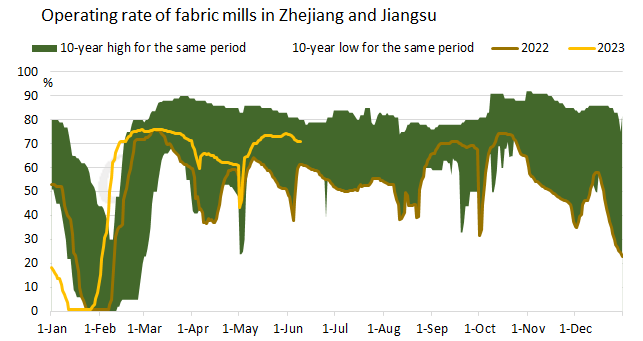
Meanwhile, operating rate of DTY plants fell by 1 percentage point to 82% in Zhejiang and Jiangsu: around 80-90% in Xiaoshan and Shaoxing, below 90% in Changxing, around 80% in Cixi, below 80% in Taicang and near 80% in Changshu. DTY plants saw less operating rate reduction mainly because they have replenished a lot of raw material. The POY stocks of DTY plants were lower around 5-10 days now.
Export data for the textile and clothing industry released on Jun 7 also showed relative weakness. In May, textile and clothing exports were US$25.32 billion, a decrease of 13.1% y-o-y and a monthly decrease of 1.3%. Among them, textile exports were US$12.02 billion, down 14.2% year on year and 5.6% on the month, while clothing exports were US$13.3 billion, a y-o-y decrease of 12.2% and an m-o-m increase of 3%. The data showed that the textile industry performed weaker.
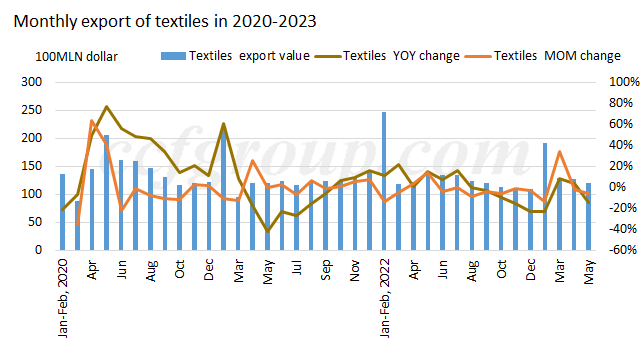
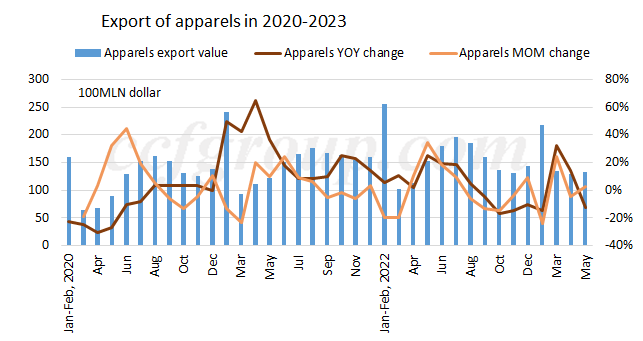
Seasonal demand tends to weaken later. Sporadic replenishment of autumn and winter fabrics may appear. After sampling orders for autumn and winter were finished in May, some players may restock in Jun-Jul. Sales of dralon fabrics improve this week. However, these sporadic orders will be hard to mitigate the high inventory burden of grey fabrics. The operating rate of fabric mills is estimated to fall back in Jun with stunted sales, with monthly level down to around 68%.
The operating rate of PFY plants and polymerization rate also gradually peaks. The comprehensive operating rate of PFY plants rises to 83.2% this week, that of direct-spun PFY plants is at 87.5% and the polyester polymerization rate is at 92.8%, which is high compared with same period of previous years and lacks momentum to ascend further as downstream market has started weakening.
With reducing operating rate of fabric mills and DTY plants, sales of PFY have sustained sluggish for around one week.
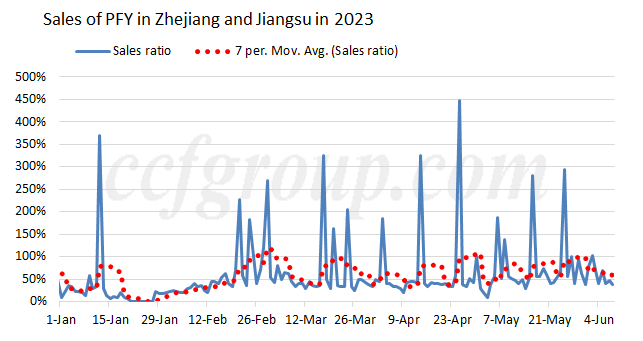
Stocks of POY and FDY are accumulating.
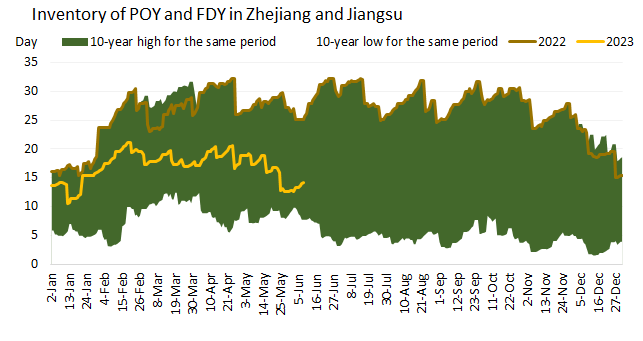
The polyester polymerization rate is expected to peak while may keep firm for a short period with low inventory, which is estimated to be above 90% in Jun. Feedstock market witnesses modest pressure in terms of supply and demand in Jun. The operating rate of PTA plants is rising, which may advance to around 84% later. Sanfame and Hengli plans to start operation. Stocks of PTA are estimated to slightly accumulate in Jun. As for MEG market, ZPC, Xinjiang Tianye and Guanghui plan to restart later. The operating rate of MEG plants is likely to rise to above 60%. The stocks of MEG may slightly reduce in Jun.
The mindset change of commodity market, crude oil and PX market are expected to affect later feedstock cost trend.
The PFY stocks of downstream plants can guarantee around 10 days of production. If feedstock cost keep consolidating, downstream buyers will continue consuming PFY prepared before. Speculative demand for PFY will be lacked. Meanwhile, rigid demand for PFY will also weaken when the operating rate of downstream plants tends to reduce. PFY plants run at high capacity. Therefore, the stocks of POY and FDY are likely to keep mounting and the social inventory may be transferred from downstream plants to upstream producers.
- Top keywords
- Cotton Price
- Cotton Futures Price
- Cotton Futures
- CZCE
- PTA Futures Price
- Chemical Fiber
- Polyester Prices
- Wool price
- PTA Futures
- Shengze Silk
- China
- Yarn Price
- price
- China Textile City
- Fibre Price
- Benzene Price
- Cotton
- Index
- Cotton Index
- PTA
- fabric price
- NYMEX
- Top 10
- textile industry
- Spot Cotton
- Cotton Yarn
- Polyester Price
- Futures
- PTA Price
- cotton yarn price

